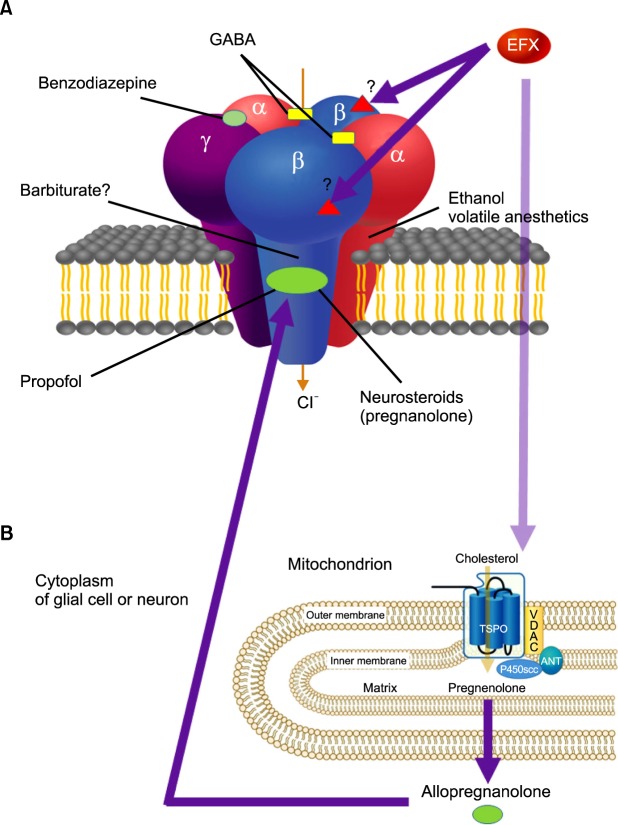Fig. 1.
Schematic action mechanism of etifoxine (EFX). Hypothetical schematic model of the GABAA receptor is a pentameric structure, with the five subunits (two α, two β, and a single γ subunit) arranged around a central chloride-selective pore. A variety of chemical compounds are capable of acting on GABAA receptors to modulate its channel function. The receptor has specific sites for each chemical compound (benzodiazepines, barbiturates, and neurosteroids), which are allosteric sites for modulation of GABA currents or chloride conductance. Etifoxine is a direct potentiation of GABAA receptor activation though a site different from the classical benzodiazepine binding motif. (A) Presumably etifoxine appears to produce its anxiolytic effects by binding to β2 and β3 subunits of the GABAA receptor complex. The effects of etifoxine are not reversed by the benzodiazepine antagonist flumazenil. (B) In addition, etifoxine modulates GABAA receptors via stimulation of neurosteroid production. This occurs through the binding of etifoxine to the 18 kDa translocator protein (TSPO) of the outer mitochondrial membrane, known as the peripheral benzodiazepine receptor (PBR). TSPO or PBR interacts with a voltage-dependent anion channel (VDAC, a protein that is present in outer mitochondrial membrane - inner mitochondrial membrane contact sites) and the adenine nucleotide transporter (ANT, in inner mitochondrial membrane) to form a complex. Cholesterol transport across the outer mitochondrial membrane through TSPO is activated by etifoxine binding to the protein. The cholesterol side-chain-cleaving cytochrome P450 enzyme (P450scc), which is located at the inner mitochondrial membrane, converts cholesterol to pregnenolone, which is further metabolized through several steps by enzymes present in the endoplasmic reticulum and finally converted into neurosteroid allopregnanolone (ALLO). ALLO acts in an autocrine and paracrine manner and are potent positive allosteric modulators of synaptic and extrasynaptic GABAA receptor. They also modulate GABAA receptor function through a binding site different from that of benzodiazepines (adapted from Rupprecht R, Papadopoulos V, Rammes G, Baghai TC, Fan J, Akula N, et al. Translocator protein (18 kDa) (TSPO) as a therapeutic target for neurological and psychiatric disorders. Nat Rev Drug Discov 2010; 9: 971-88).

